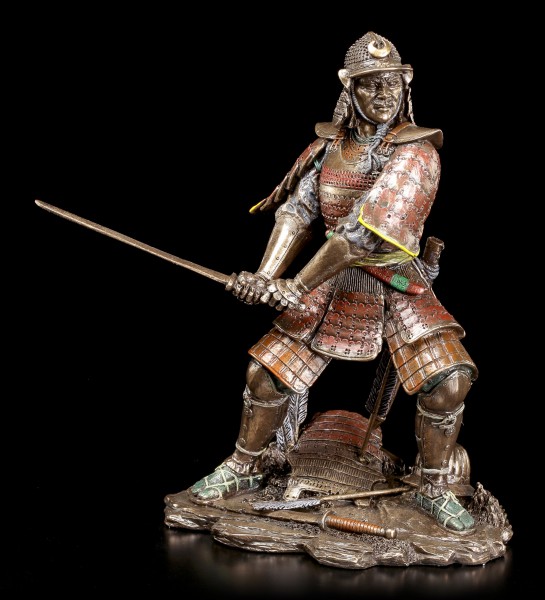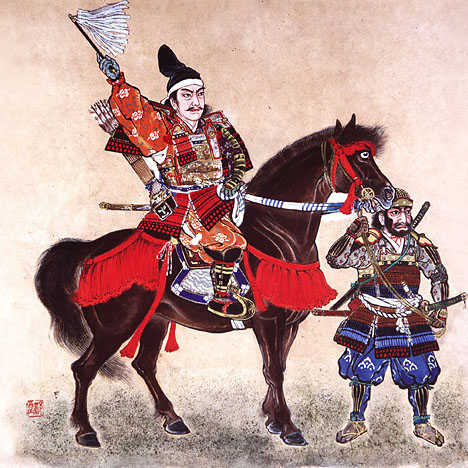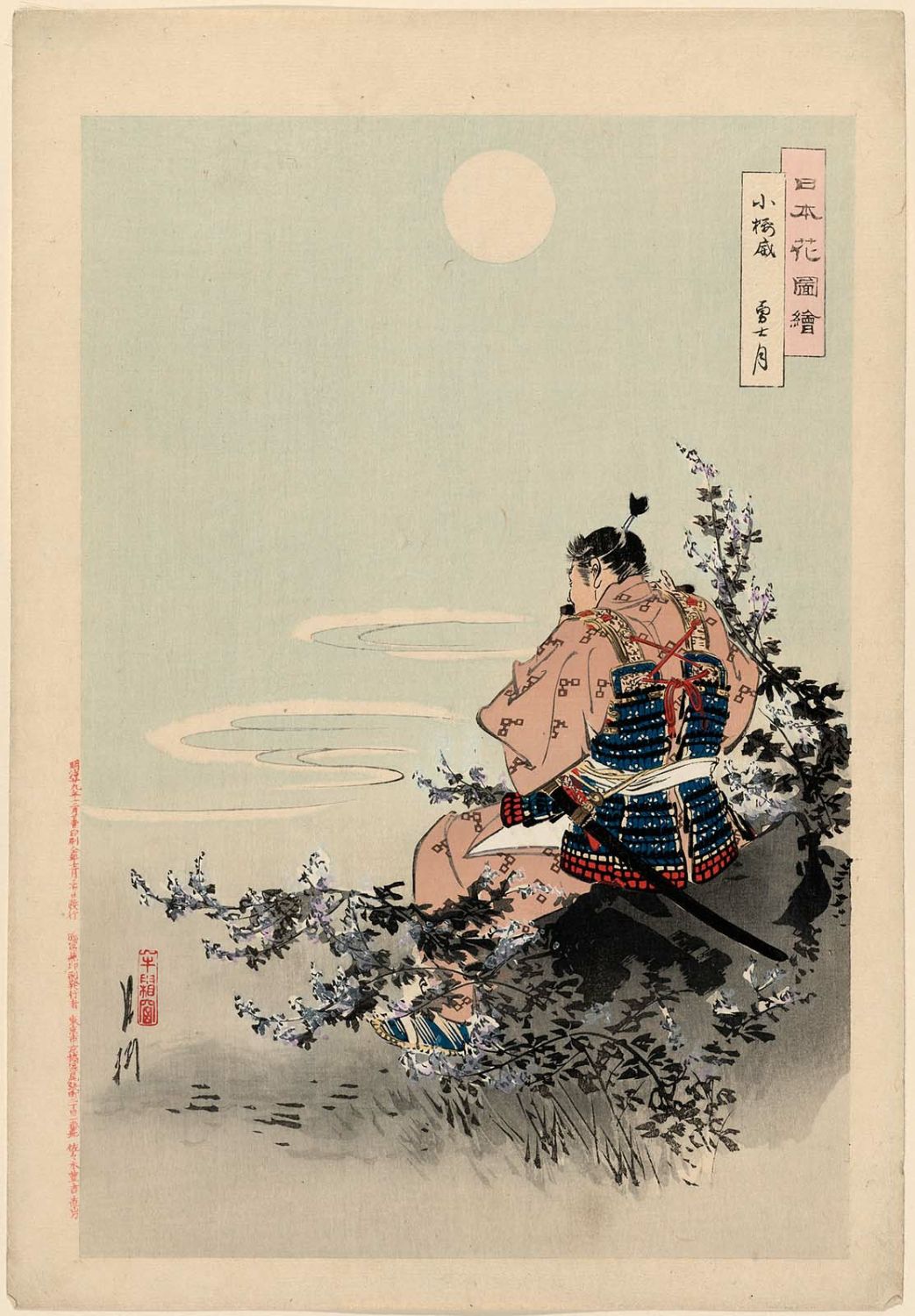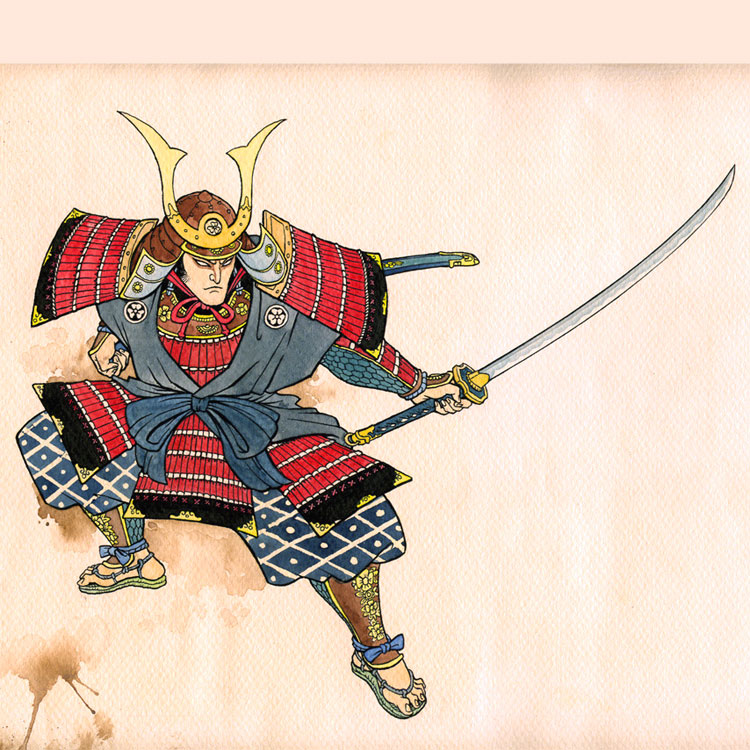The Samurai
 The word ‘samurai’ has an etymological origin that might surprise those who associate it with fierce and independent warriors. It derives from the Japanese term saburau and originally had to do with the idea of devoted and loyal service to the noble class, a type of specialized karma yoga, accompanied by key skills (mostly related to protection). The word saburau eventually came to be pronounced as ‘saburai’, and then ‘samurai’. A samurai was, therefore, both a servant and a warrior—in principle, a warrior who served a noble cause (although, it goes without saying that the people or person he served may, on occasion, have been anything but noble).
The word ‘samurai’ has an etymological origin that might surprise those who associate it with fierce and independent warriors. It derives from the Japanese term saburau and originally had to do with the idea of devoted and loyal service to the noble class, a type of specialized karma yoga, accompanied by key skills (mostly related to protection). The word saburau eventually came to be pronounced as ‘saburai’, and then ‘samurai’. A samurai was, therefore, both a servant and a warrior—in principle, a warrior who served a noble cause (although, it goes without saying that the people or person he served may, on occasion, have been anything but noble).
Samurai were given a popular boost of Hollywood star power via Tom Cruise’s role in the 2003 film The Last Samurai (though many would argue that it was Ken Watanabe’s charismatic presence as the samurai lord, along with Hiroyuki Sanada as his brave and loyal captain, who anchored the movie). Historical quibbles notwithstanding, the movie did a good service in representing the samurai as a three-fold figure: courageous and accomplished fighter, a fierce loyalist to his cause, and spiritual man (he regularly meditated) who also had a love of the arts and the omnipresent beauty of nature. Melodramatic romanticism aside (and the movie did have that) it was a clear and moving statement about the old values of honor and discipline in the face of modern deadly technology and the less than honorable men who too often wield it
Japanese mythology is closely intertwined with martial symbolism. Legend has it that the entire country was created by a weapon—a spear wielded by the god Izanagi and the goddess Izanami. They thrust the spear into the ocean, and upon lifting it, four drops fell into the sea and formed the islands of Japan. The descendants of the current race of Japanese occupying the islands arrived about three thousand years ago, although where they came from is still a matter of speculation (Asia, Korea, or the south Pacific). There was an indigenous population already there (the Ainu) who were soon conquered and pushed to the northern island.
 The samurai have their roots in the feudalism of Japan’s past, taking form during the reign of the first recognized shogun, Minamoto no Yoritomo (1147-1199). It was during this time that the professional class of warriors, the samurai, truly came into their own. In several respects they were parallels of the knights of Middle Age Europe of that same time. The golden age of the samurai lasted until around the middle of the 15th century. Much like the Mongols of that time their main weaponry consisted of the simple bow and arrow, wielded with deadly accuracy and speed. The period from the 16th to the early 17th century involved a great deal of domestic warfare as Japan shifted from a tribal society ruled by warlords to a unified nation, which naturally involved struggle and bloodshed as the changes were resisted. Guns made their appearance at this time, intensifying the overall bellicosity of feuding clans, although the samurai code was interpreted at the time as requiring the rejection of guns.
The samurai have their roots in the feudalism of Japan’s past, taking form during the reign of the first recognized shogun, Minamoto no Yoritomo (1147-1199). It was during this time that the professional class of warriors, the samurai, truly came into their own. In several respects they were parallels of the knights of Middle Age Europe of that same time. The golden age of the samurai lasted until around the middle of the 15th century. Much like the Mongols of that time their main weaponry consisted of the simple bow and arrow, wielded with deadly accuracy and speed. The period from the 16th to the early 17th century involved a great deal of domestic warfare as Japan shifted from a tribal society ruled by warlords to a unified nation, which naturally involved struggle and bloodshed as the changes were resisted. Guns made their appearance at this time, intensifying the overall bellicosity of feuding clans, although the samurai code was interpreted at the time as requiring the rejection of guns.
The warrior-clans who originally dominated Japanese culture promoted certain values that later became synonymous with the legend of the samurai. First among these was deep loyalty, especially to their leaders. The second was a remarkable courage in battle that was based crucially on the ‘never retreat’ discipline. This ‘discipline’ can of course be severely double edged: either decisively brave or maniacally suicidal. But it forms the essential attitude of the samurai brand of the warrior.
 These twin qualities of loyalty and utter fearlessness were married to a third, that of a refined sense of aesthetics. Samurai warriors have always been unique in their sense of artistry, from their elaborate dress and armor to their appreciation of various forms of art and writing, to their traditional association with the bamboo flute. This latter instrument perhaps captures the ideal of the ‘inner samurai’ as much as anything: solitary, soulful, and in tune with the softer rhythms of nature—even as the ‘outer samurai’ brandished his weapons and bristled with a pit bull-like eagerness and readiness for battle.
These twin qualities of loyalty and utter fearlessness were married to a third, that of a refined sense of aesthetics. Samurai warriors have always been unique in their sense of artistry, from their elaborate dress and armor to their appreciation of various forms of art and writing, to their traditional association with the bamboo flute. This latter instrument perhaps captures the ideal of the ‘inner samurai’ as much as anything: solitary, soulful, and in tune with the softer rhythms of nature—even as the ‘outer samurai’ brandished his weapons and bristled with a pit bull-like eagerness and readiness for battle.
These are of course ideals. The real samurai was an imperfect human being. Much as many accomplished Zen masters got caught up in the politics of Japan’s involvement in the great wars of the 20th century, so too did the samurai of old get entangled in the politics and tribalism that drove much of Japanese history.
In some respect the samurai were the very embodiment of romanticism, in that they held fast to old and cherished values and often refused to relinquish them even in the face of sweeping modern changes. The best example of that occurred in the 16th century when gunpowder and firearms became openly available in Japan. The samurai resisted the new technology and conspired to remove the firearms from the country and keep them out for over two centuries, during which time the samurai and his iconic two swords—perhaps the ultimate symbols of masculine power—remained sovereign over the land.(1)
Bushido and the Code of the Samurai
Bushido is the warrior code of the samurai, similar in some respects to the English term ‘chivalry’ (especially as it applied to European knights of the Middle Ages). The word itself translates as ‘military-knight-ways’ or more simply as ‘the way of the warrior’. Bushido applied to not just any warrior, but rather to aristocratic warriors, and the ways in which these warriors should comport themselves when not engaged in battle. The French expression noblesse oblige is key here; meaning ‘nobility obliges’ it refers to the importance of living up to one’s station in life—earning it, by demonstrating quality behavior and good works in the world, thereby showing that one has gone beyond mere entitlement.(2)
There were many tracts and codes written in the last millennia on Bushido and samurai ethics. One of the more well-known of these is Daidoji Yuzan’s Code of the Samurai, written in the 16th century. Yuzan was himself a samurai as well as a military strategist and advisor. His work was first translated into English in the early 1940s. Although not as renowned as Sun Tzu’s Art of War it has held equal value and influence on military men over the centuries.
The Samurai code—Bushido, the Way of the Warrior—has been most commonly represented by two preliminary points and eight general points:
- Awareness of Death. The key defining feature of a samurai warrior was thought to be his ever-vigilant stance, and a perpetual awareness of his mortality. This kept him sharp, alert, on purpose, excellent in his performance, and humble.
- Contemplation. A samurai warrior held much in common with a Zen monk, such as marked abilities in focus, concentration, and discipline. A warrior who was tuned into his deep spiritual nature, and the cosmos around him, was far more advanced than one who merely mastered the physical martial arts.
- Integrity. Sometimes this word is rendered as ‘rectitude’, ‘justice’, or ‘knowing right from wrong’. The modern expression of it is ‘do the right thing’. It was thought to be the most important of all qualities for a samurai to exercise. Bushido itself was defined as this quality, so important was it regarded. It included, naturally, the understanding of when was the right time to die, not simply when it was right to do something for one’s advantage.
- Courage. This is not a blind courage. It is courage backed by clarity and understanding of what is right in each moment. (Hence the importance of Code #1). For example, to see what is right and to fail to do it is symptomatic of the opposite of courage, cowardice.
- Compassion and Mercy. A true warrior is not cruel. The greater his skill and power in life, the greater is his need to demonstrate mercy and compassion
- Politeness. This kind of behavior is easily misunderstood as affected or inauthentic, but in fact to be courteous—to treat others well—is a form of empathy and reflects higher spiritual awareness that one is ultimately not separate from anything, even one’s enemy.
- Honesty and Sincerity. This typically referred to the importance of a samurai shunning greed and materialism. He was not expected to understand the ways of commerce or business, but if he did, was expected to be humble, simple, and to disdain unnecessary wealth.
- Honor. A samurai was expected to conduct himself with dignity. He was not to be too reactive or to get involved in petty matters. He was encouraged to associate with those of similar lofty character. For those reasons, he was encouraged to not form friendships casually, in case he became entangled with small-minded affairs.
- Loyalty. This was originally meant as loyalty to one’s samurai superiors—to honor the chain of command—but applies also in the general sense of being loyal to a good and just cause greater than oneself.
- Character and Restraint. The character and restraint spoken of here represented, for the samurai, an absolute moral code, having its roots in an understanding of right and wrong that was beyond intellectual debate. This ‘moral code’ was not a mere doctrine, however; it rather had its basis in a refined and developed sense of what was right for any given situation.
Mining the Virtues of the Samurai
Mining the virtues of the samurai is not difficult, if only because the samurai character was very black and white, lacking in ambiguity. ‘Kill or be killed’—the essential battle cry of the samurai—is not any shade of gray. Such a code has no chance of working literally in the life of a conscious warrior (barring, obviously, exceptional circumstances). But as a metaphor it is very powerful. ‘Kill or be killed’—or ‘never retreat and take no prisoners’—can be understood as a profound commitment to one’s life and work in which the key feature is totality. This totality is sometimes summed up in the modern two-word expression ‘all in’. To be all in is to be so committed that all escape hatches are sealed, and all run-away bridges burned. It is a discipline of mind in which one is utterly committed to true effort and a refusal to allow apathy, fear, thoughts of unworthiness, thoughts of giving up for fear of failure or of what others will think of you, and so forth, to control one’s forward movement.
 The ‘all in’ attitude also makes for a standout teammate. It is disquieting and distracting to operate on a team of any sort all the while doubting the attitude of a colleague. The proverbial weak-link in a company or on a team can be enough to not only cause problems but to sink the entire ship. The samurai attitude of totality of intent is an essential piece in the character of the trustworthy warrior and how he operates in community of whatever sort.
The ‘all in’ attitude also makes for a standout teammate. It is disquieting and distracting to operate on a team of any sort all the while doubting the attitude of a colleague. The proverbial weak-link in a company or on a team can be enough to not only cause problems but to sink the entire ship. The samurai attitude of totality of intent is an essential piece in the character of the trustworthy warrior and how he operates in community of whatever sort.
The famed loyalty of the samurai is also a prized virtue. In its best sense, it is not a dumb loyalty, blind to the realities under its nose. (To be loyal to an obviously corrupt cause or criminal is what the legal system calls an ‘accomplice’ and is usually a bad thing). Loyalty in its purified state is an egoless stance that sees the value in supporting a vital cause, even if it means that one’s personal stature is not recognized or rewards for such loyalty are not immediately obvious. (It is here where such loyalty is tested; if rewards are immediate, we have no way finding out how grown up we are). The male psyche, in its more egotistical manifestations, is inclined toward boasting, exaggerating his value in the eyes of others to inflate his confidence and quash his insecurities. The confidence achieved by boasting is, however, artificial, and sooner or later collapses as the deception is detected by others. True loyalty to a worthy cause is an excellent, and often vitally necessary, antidote to the problems of pride, boasting, and narcissistic tendencies.
The third element of the samurai, his developed aesthetic sense, is a vitally important element for a conscious warrior because it prevents him from becoming out of balance (hyper-masculine). A hyper-masculine man has disconnected inner centers (his mental, emotional, and physical bodies). His emotional body is not well developed. He is out of touch with his human side and struggles to relate to people from a position of equality. He tends to impose his mental or physical centers on others, seeking to dominate in some fashion. By developing some aesthetic sensibilities, the conscious warrior stands a better chance of achieving a harmonious balance between his inner centers. That, in turn, will tend to be positively reflected in his outer relationships.
Notes:
- John Keegan, A History of Warfare, Vintage, 1993, (pp. 40-41).
- Inazo Nitobe, Bushido: The Soul of Japan (Kodansha International, revised edition, 1905, reprinted in 2002), pp. 34-35.
Copyright 2018 by P.T. Mistlberger, all rights reserved